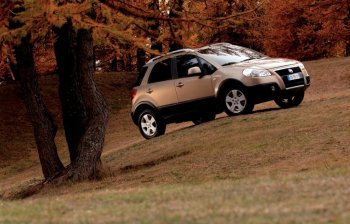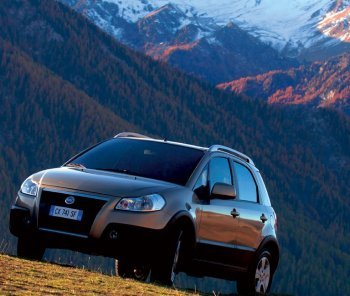|
OFF ROAD
PERSONALITY FOR LEISURE TIME
|
|
The Fiat Sedici
was created to overcome any on-road situation without ever
stooping to compromise. This is evident in its rigid,
reinforced chassis and also the adoption of
electronically-controlled 4x4 drive that distributes
variable torque to front and rear wheels.
In particular, the Fiat Sedici adopts a new on-demand 4x4
system with central differential and 3 operating modes that
combines the performance of a true off-roader with the
driving comfort of a road vehicle. It represents a blend of
four wheel drive and front wheel drive systems and therefore
exploits the best of both these systems. Under normal
conditions, the Fiat Sedici system therefore behaves like a
transmission with two drive wheels with the benefit of lower
fuel consumption and lower emission levels. When road
conditions decline and grip is lost, the system acts as a
4x4 transmission, automatically modulating torque
distribution between the front and rear axle to increase
vehicle safety.
The heart of this specific transmission is an electric dry
multi-plate clutch coupling system (operated by an
electromagnet) that modulates the transferred torque
electronically according to the need for traction. More
specifically, the electrical pulse that generates the
magnetic field to couple the plate arrives when the ABS
sensors detect relative slip between front and rear wheels.
This allows the system to change over from a 2WD to a 4WD
transmission simply and quickly: all you have to do is
operate a key on the dashboard to select one of the three
operating modes (2WD, AUTO and LOCK) without the need for a
separate gear lever.
|
 |
|
 |
|
More specifically, only the front wheels transmit torque
with the 2WD function. The 4x4 is not engaged and there are
no dissipation effects. This mode is better suited for
normal driving conditions (dry road) and to achieve the
lowest possible fuel consumption.
The second function is AUTO: in most cases, the torque is
transmitted to the front wheels. The distribution of torque
between front and rear is controlled automatically. The
system supplies optimum torque to the rear wheels when the
sensors detect low grip and also to anticipate a loss in
traction (e.g. during acceleration).
In LOCK mode, torque distribution is locked to ensure
prompt, stable take-off under extreme conditions (sand, mud
and snow). Under these conditions, the torque distribution
ratio is 50 to 50 between front and rear axles. This mode is
maintained up to 60 km/h and then transfers to Auto mode to
ensure a more comfortable drive. Due to this specific
four-wheel drive system and a minimum ground clearance of 19
centimetres, the new model can cover uneven, difficult
ground with ease, as the ramp angle values reveal (standard
A). Firstly, the rear incidence angle (31.1°), which is the
maximum gradient climbable in reverse from a horizontal
plane. Next comes the slope angle (18.1°), i.e. the maximum
possible angle at the base of a triangular slope (isosceles)
if it is to be driven up without the bottom of the car
touching the ground. Last is the front incidence angle
(20.3°), a measure of the maximum front angle that may be
tackled by an off-road vehicle without the body touching the
ground. |
|